Peculiar Ground Halo Spokes - OPOD
Peculiar Ground Halo Spokes - Exploring a Fascinating Atmospheric Phenomenon
When it comes to atmospheric optics, there are some truly mesmerizing phenomena that can occur. One such phenomenon is the peculiar ground halo spokes, which were first observed by Jari Luomanen on a winter afternoon in Finland. Luomanen noticed unusually bright and glittering snow, and upon closer inspection, discovered a strange display of halo spokes radiating across the snow from the low winter sun. This phenomenon captured his curiosity, leading him to investigate further.
The halo spokes appeared as bright but diffuse streaks extending from the sun at specific clock angles, mainly around 5:30 and 6:30. However, wider spokes were also visible at approximately 3:00 to 4:30 and 7:30 to 9:00. Each spoke consisted of individual ice crystals that glinted brightly, adding to the ethereal beauty of the spectacle.
To understand the nature of these halo spokes, Luomanen examined the ice crystals responsible for their formation. Through macro lens images, he discovered thin shard-like dendritic plates. These plates exhibited a mean tilt of 20° from horizontal for the 5 and 7 o'clock spokes, while the broader 4 and 8 o'clock spokes originated from plates with a mean tilt of 65° from horizontal. Both populations of crystals displayed a small standard deviation in tilt and covered all azimuthal rotational orientations.
To gain further insights, Luomanen employed ray tracing simulations using HaloPoint 2.0 software. These simulations confirmed that two distinct populations of crystals were necessary to accurately reproduce the observed halo spokes. The mean tilt and tilt distribution width of these crystals played a crucial role in determining the appearance of the spokes. Interestingly, attempts to simulate the phenomenon using tilted stubby hexagonal crystals with two populations of faces tilted 90° did not yield satisfactory results.
Upon closer examination of the ice shards, it became evident that the two populations of plates had varying orientations. Some plates were strongly tilted upwards, while others lay almost flat. These dendritic plates measured approximately 1mm in length and were not initially noticeable to the naked eye. The macro shots revealed their unique characteristics, highlighting the importance of careful observation and investigation in uncovering such atmospheric phenomena.
To gain a better understanding of the meteorological conditions that contributed to the formation of these peculiar ground halo spokes, Luomanen referred to weather data from his nearby weather station. The data revealed that the previous night had favored large crystal growth, with the dew point closely following the air temperature. Additionally, the cold temperatures throughout the day prevented significant sublimation of the crystals. These conditions likely played a role in creating an environment conducive to extreme crystal growth and the subsequent formation of the halo spokes.
Interestingly, similar halo spokes have been observed in Alaska by Walt Tape of Atmospheric Halos. While the 5:30 and 6:30 spokes were remarkably similar to those observed by Luomanen, there was no sign of the 4 and 8 o'clock spokes. This discrepancy could be attributed to the difference in sun angle, with the Alaskan sun being 11° high compared to the 6° sun in Finland. Simulations using the same crystals at different sun angles revealed that the outer halos would be less visible under higher sun angles.
In conclusion, the discovery of peculiar ground halo spokes provides us with a captivating glimpse into the world of atmospheric optics. These spokes, formed by ice crystals with specific orientations and under favorable meteorological conditions, create a stunning visual display against the backdrop of snow-covered landscapes. The diligent efforts of researchers like Jari Luomanen shed light on the intricate mechanisms behind such phenomena and encourage us to observe and appreciate the wonders that surround us in the natural world. So, keep a keen eye out for halo spokes this winter and be prepared to witness the awe-inspiring beauty they bring to the atmosphere.

Peculiar Ground Halo Spokes
Jari Luomanen (atmospheric phenomena) noticed on one afternoon (Feb 27, '12) unusually bright and glittering snow. Well aware that ground lying ice crystals can form ground halos he searched the fields and found this strange phenomenon.
Bright but diffuse halo spokes radiate across the snow from the low Finland winter sun at about 5.30 and 6.30 as clock angles go. There are wider spokes at 3-4.30 and 7.30-9. Individual crystals glint brightly.
All images ©Jari Luomanen, shown with permission

Ice crystals were obviously responsible but of what type and how oriented?
Jari took some macro lens images that revealed (example below) very thin shard-like dendritic plates. Assuming external reflection from their larger faces Jari ran ray tracing simulations using HaloPoint 2.0 The simulation at left (green points) employed two crystal populations.
The 5 and 7 o’clock spokes come from plates with a mean tilt of 20° from horizontal (tilt standard deviation only 5°). The broader 4 and 8 o’clock spokes are generated by plates with a mean tilt of 65° from horizontal and an equally small standard deviation. Both populations take all azimuthal rotational orientations.
Jari spent some considerable time in optimisation and later we played with other orientations in a video session. Tilted stubby hexagonal crystals offering two populations of faces tilted 90° (suggested to avoid two apparently arbitrary populations) simulate rather less well.
Two populations really are needed and the spokes are remarkably sensitive to the mean tilt and the tilt distribution width.

The ice shards, clearly dendritic.
The two populations are evident, some plates strongly tilted upwards, other lying almost flat. The plates are about 1mm long. By eye the snow/crystal crust looked quite normal, the unusual crystals were only revealed by the macro shots.

Jari has a weather station 5km away and here are the conditions from the previous midnight through to the following one. The halo photo was taken at ~1600 and the crystal images at 1930 by flash illumination.
The previous night favoured large crystal growth with the dew point closely following the air temperature. The day was also sufficiently cold that the crystals did not significantly sublime.
"Of course, the microclimate just on top of the snow sheet is bound to have its quirks but this log from my station gives us hints about the reasons behind this extreme xtal growth."

From Finland to Alaska.
An image captured by Walt Tape (Atmospheric Halos) showing remarkably similar 5.30 and 6.30 spokes. However, there is no sign of Jari's 4 and 8 o'clock ones. The Alaskan sun was 11° high compared to the 6° in the Finland images. Simulations using the same crystals at 6° and 11° sun show that the outer halos would be less visible.
Is this coincidental? Or do dendrite shards under some meteorological conditions stack naturally with tilts of 20 and 65 degrees?
We need more observations. Observe ice and snow closely this winter and look for halo spokes.
Note: this article has been automatically converted from the old site and may not appear as intended. You can find the original article here.
Reference Atmospheric Optics
If you use any of the definitions, information, or data presented on Atmospheric Optics, please copy the link or reference below to properly credit us as the reference source. Thank you!
-
<a href="https://atoptics.co.uk/blog/peculiar-ground-halo-spokes-opod/">Peculiar Ground Halo Spokes - OPOD</a>
-
"Peculiar Ground Halo Spokes - OPOD". Atmospheric Optics. Accessed on November 21, 2024. https://atoptics.co.uk/blog/peculiar-ground-halo-spokes-opod/.
-
"Peculiar Ground Halo Spokes - OPOD". Atmospheric Optics, https://atoptics.co.uk/blog/peculiar-ground-halo-spokes-opod/. Accessed 21 November, 2024
-
Peculiar Ground Halo Spokes - OPOD. Atmospheric Optics. Retrieved from https://atoptics.co.uk/blog/peculiar-ground-halo-spokes-opod/.